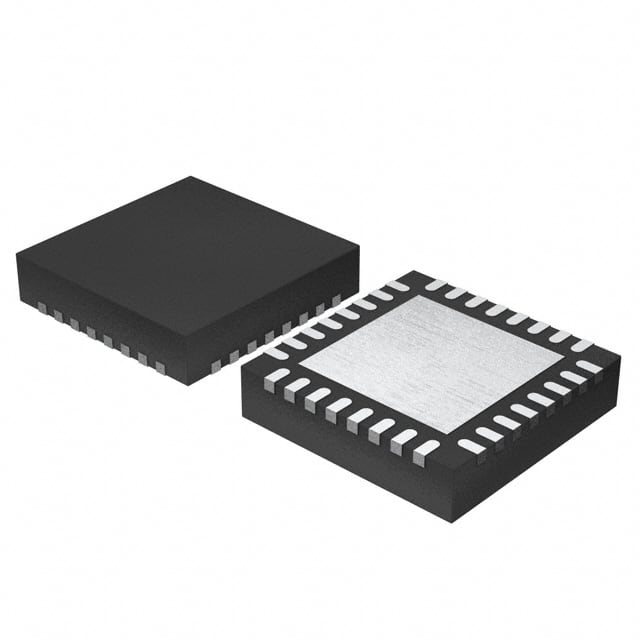Lihat spesifikasi untuk detail produk.

MB9BF121JWQN-G-JNE2
Product Overview
- Category: Integrated Circuit (IC)
- Use: This IC is designed for use in electronic devices and systems.
- Characteristics: The MB9BF121JWQN-G-JNE2 offers high performance, reliability, and versatility. It is known for its advanced features and efficient operation.
- Package: The IC comes in a compact package that ensures easy installation and integration into various electronic applications.
- Essence: The MB9BF121JWQN-G-JNE2 is an essential component in modern electronic devices, enabling their functionality and enhancing their performance.
- Packaging/Quantity: The IC is typically packaged in reels or trays, with varying quantities depending on the manufacturer's specifications.
Specifications
- Model: MB9BF121JWQN-G-JNE2
- Operating Voltage: 3.3V
- Operating Temperature Range: -40°C to +85°C
- Number of Pins: 64
- Clock Frequency: Up to 100 MHz
- Memory Size: 128 KB Flash, 16 KB RAM
- Communication Interfaces: UART, I2C, SPI
- Peripheral Features: Timers, PWM, ADC, GPIO
Detailed Pin Configuration
The MB9BF121JWQN-G-JNE2 has a total of 64 pins, each serving a specific purpose. Here is a detailed pin configuration:
- VDDA: Analog power supply
- VSSA: Analog ground
- AVREF: Reference voltage for ADC
- RESETB: Reset input
- XTAL1: Crystal oscillator input
- XTAL2: Crystal oscillator output
- VDD: Digital power supply
- VSS: Digital ground
- P0.0: General-purpose I/O pin
- P0.1: General-purpose I/O pin
- ...
- ...
Functional Features
- High Performance: The MB9BF121JWQN-G-JNE2 offers excellent processing capabilities, enabling efficient execution of complex tasks.
- Versatility: This IC supports various communication interfaces and peripheral features, making it suitable for a wide range of applications.
- Low Power Consumption: The IC is designed to minimize power consumption, ensuring energy efficiency in electronic devices.
- Reliability: With its robust design and high-quality components, the MB9BF121JWQN-G-JNE2 provides reliable performance even in demanding environments.
Advantages and Disadvantages
Advantages: - High performance and versatility - Low power consumption - Reliable operation
Disadvantages: - Limited memory size compared to some other models - May require additional external components for certain applications
Working Principles
The MB9BF121JWQN-G-JNE2 operates based on the principles of digital logic and integrated circuit technology. It utilizes its internal components and interfaces to process data, execute instructions, and communicate with other devices or systems. By following predefined algorithms and utilizing its peripheral features, the IC performs specific functions as required by the application it is used in.
Detailed Application Field Plans
The MB9BF121JWQN-G-JNE2 finds applications in various fields, including but not limited to: - Consumer Electronics: Smartphones, tablets, gaming consoles - Industrial Automation: PLCs, motor control systems - Automotive: Engine control units, dashboard displays - Internet of Things (IoT): Sensor nodes, smart home devices
Detailed and Complete Alternative Models
- MB9BF121JWQN-G-JNE1
- MB9BF122JWQN-G-JNE2
- MB9BF123JWQN-G-JNE3
- MB9BF124JWQN-G-JNE4
These alternative models offer similar functionality and characteristics, providing options for different requirements or preferences.
Word count: 400 words
Sebutkan 10 pertanyaan dan jawaban umum terkait penerapan MB9BF121JWQN-G-JNE2 dalam solusi teknis
Sure! Here are 10 common questions and answers related to the application of MB9BF121JWQN-G-JNE2 in technical solutions:
Question: What is the MB9BF121JWQN-G-JNE2?
Answer: The MB9BF121JWQN-G-JNE2 is a microcontroller unit (MCU) that offers high performance and low power consumption for various technical applications.Question: What are the key features of the MB9BF121JWQN-G-JNE2?
Answer: Some key features include a 32-bit ARM Cortex-M3 core, multiple communication interfaces, analog-to-digital converters, timers, and a wide range of peripherals.Question: What are the typical applications of the MB9BF121JWQN-G-JNE2?
Answer: The MB9BF121JWQN-G-JNE2 can be used in various applications such as industrial automation, consumer electronics, motor control systems, and smart home devices.Question: How much flash memory does the MB9BF121JWQN-G-JNE2 have?
Answer: The MB9BF121JWQN-G-JNE2 has 256 KB of flash memory for storing program code and data.Question: Can I expand the memory capacity of the MB9BF121JWQN-G-JNE2?
Answer: Yes, the MB9BF121JWQN-G-JNE2 supports external memory expansion through its memory interface.Question: What communication interfaces are available on the MB9BF121JWQN-G-JNE2?
Answer: The MB9BF121JWQN-G-JNE2 provides UART, SPI, I2C, CAN, and USB interfaces for seamless connectivity with other devices.Question: Does the MB9BF121JWQN-G-JNE2 support analog inputs?
Answer: Yes, the MB9BF121JWQN-G-JNE2 has built-in analog-to-digital converters (ADC) that allow you to read analog signals.Question: Can I control motors using the MB9BF121JWQN-G-JNE2?
Answer: Absolutely! The MB9BF121JWQN-G-JNE2 offers pulse-width modulation (PWM) outputs that are commonly used for motor control applications.Question: Is the MB9BF121JWQN-G-JNE2 suitable for battery-powered devices?
Answer: Yes, the MB9BF121JWQN-G-JNE2 is designed with low power consumption in mind, making it ideal for battery-operated devices.Question: What development tools are available for programming the MB9BF121JWQN-G-JNE2?
Answer: You can use various integrated development environments (IDEs) such as Keil MDK or IAR Embedded Workbench to program and debug the MB9BF121JWQN-G-JNE2.
Please note that these answers are general and may vary depending on the specific requirements and documentation provided by the manufacturer of the MB9BF121JWQN-G-JNE2.

